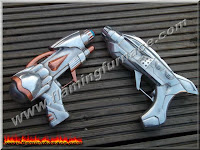


As I did mention before it is good practice to pre-heat any ingots or scrap aluminum before throwing it into the crucible molten aluminum. Two reasons, one: cold metal will "freeze" the molten metal in the crucible and second: to eliminate moisture coming in contact with molten metal if ingots where left in the wet. You can see in my foundry I used mesh on the top of the lid hole that works perfect for me. Very important to work safe with foundry gloves and pliers when lifting and placing hot ingots into the crucible and also face shield protection.
In one of my visits down the beach I found a pressure cooker lid washed ashore so that happily got a new "life" in my crucible and I also melted my sons broken scooter ;-)
The last image is scrap aluminum from my old electric router and sander. What ever scrap is to big to fit into my crucible it ends up chopped up or broken with a heavy hammer but they all end up as nice ingots ready to become a new object.....






In the next images you can see the aluminum spoon and chicken turned out very well and all the left over aluminum turned back into ingots.





The sprue and riser did their job and you can see in the image that the casting was "feeding" from it while it was in the solidifying stage. After cutting off the sprue and riser I gave the casting a bit of cleaning with a metal file. Then some light sanding and polishing on the buffing wheel.
Now its ready for custom engraving.










































